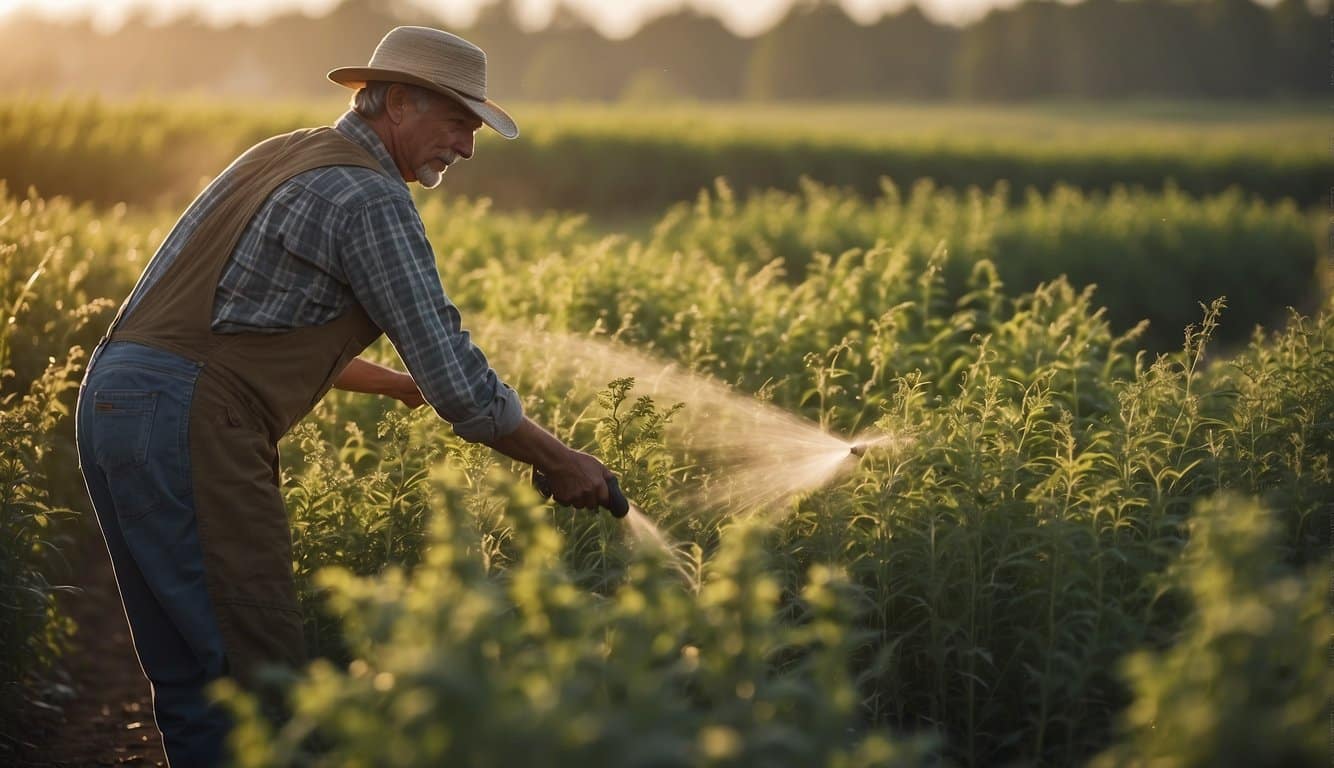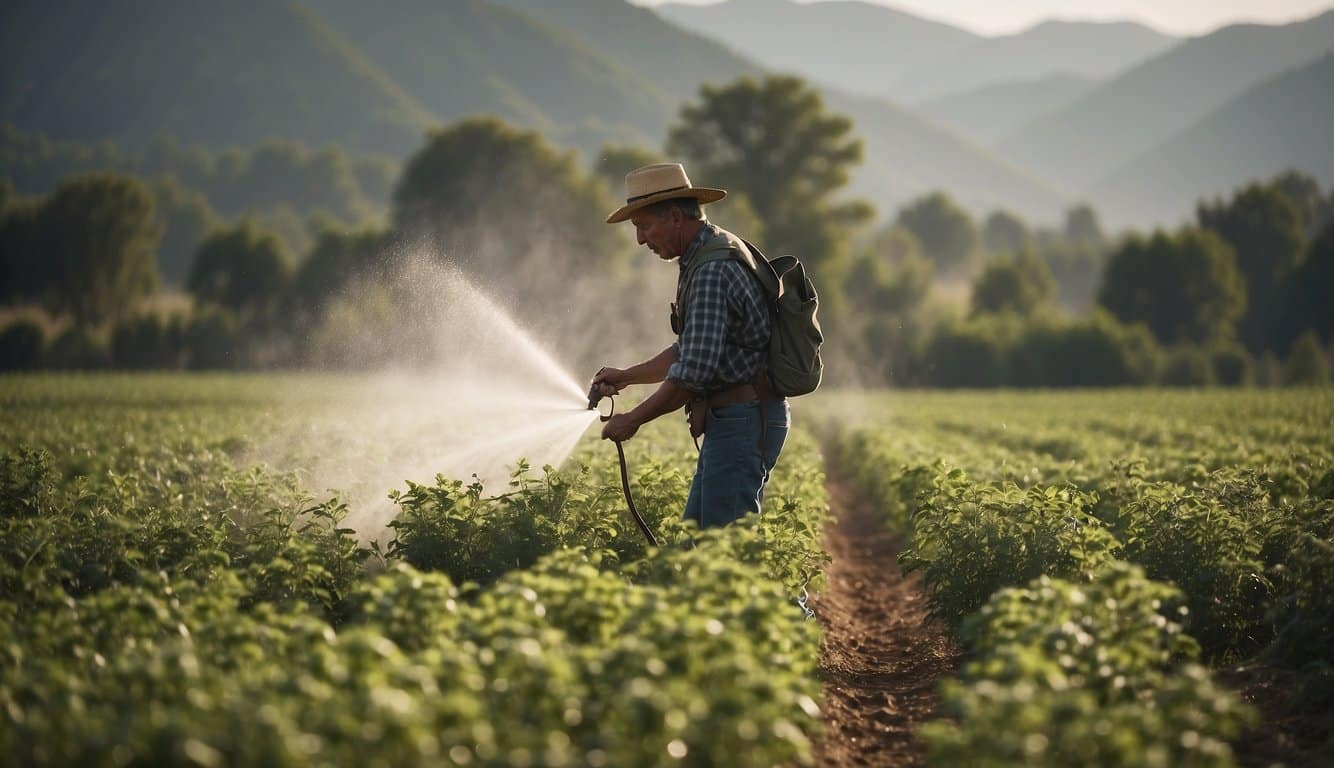Selecting the right weed killer for a task is crucial for both effective garden management and environmental stewardship.
RM43 and Roundup are two herbicides commonly pitted against each other by both professionals and enthusiasts in the battle for a weed-free environment.
RM43, known for its powerful weed-killing and prevention properties, can keep an area clear of any plant growth for up to 12 months.
Meanwhile, Roundup is recognized for its broad-spectrum effectiveness in eliminating weeds and grass but typically does not offer the same long-term prevention as RM43.

Each herbicide carries its own set of use cases, advantages, and considerations.
While RM43 contains ingredients that are especially potent in preventing future growth, its application requires careful handling and precision to avoid undesired plant harm.
Roundup’s formula, on the other hand, may be preferred for areas where vegetation will be reintroduced or for regular maintenance where long-term prevention is not required.
Users must weigh factors such as the intended application area, desired duration of weed prevention, and potential environmental impact before making an informed decision.
Key Takeaways
- RM43 is favored for long-term weed prevention, while Roundup is commonly used for general weed control.
- Selecting the appropriate herbicide depends on specific needs, including the application area and duration of effectiveness.
- Considerations for environmental impact and adherence to regulations are essential in the decision-making process.
Overview of RM43 and Roundup
Both RM43 and Roundup are recognized for their effective control of unwanted vegetation. They offer different benefits due to their unique chemical compositions and are designed to target a variety of weeds and grasses.
Chemical Composition
RM43:
- Active Ingredients:
- Glyphosate (43.68%)
- Imazapyr (0.78%)
Roundup:
- Active Ingredients:
- Glyphosate (Varies by product type, but generally lower than RM43)
RM43 distinguishes itself with the inclusion of imazapyr alongside a higher concentration of glyphosate, enhancing its ability to prevent the regrowth of weeds.
Roundup, on the other hand, relies solely on glyphosate as its herbicidal agent.
Target Weeds and Grasses
RM43 targets a wide array of vegetation, being particularly effective thanks to its dual-ingredient formula. It is known for:
- Killing tough weeds
- Lasting effects that prevent plant regrowth for up to 12 months
Roundup is formulated to kill:
- A broad range of weeds and grasses
- Some products are specific to particular types of vegetation
The presence of imazapyr in RM43 means it can control a more diverse range of plants and provide longer-lasting weed prevention compared to Roundup.
Application and Usage
In the battle of weed management, knowing how to apply RM43 and Roundup effectively, as well as understanding the scenarios each is suited for, is crucial. Proper safety measures are essential to protect both users and the environment.
Application Methods
RM43 and Roundup share similar application methods:
- Both can be applied with a tank sprayer or handheld sprayer.
- It is important to maintain a consistent spray pattern for uniform application.
Recommended Usage Scenarios
RM43:
- Ideal for non-crop areas like gravel paths, driveways, and along fences.
- Suited for areas where complete vegetation removal is required.
Roundup:
- Recommended for gardens and lawns where selective weeding is necessary.
- Suitable for spot treatments rather than widespread vegetation removal.
Safety and Precautions
When handling either herbicide, individuals should:
- Wear protective clothing, including gloves and eye protection.
- Follow the manufacturer’s instructions for mixing ratios and application procedures.
- Ensure that neither herbicide drifts onto desirable plants or areas where wildlife can be affected.
Effectiveness and Performance
When comparing RM43 and Roundup, consumers are primarily concerned with the efficacy of weed control and the duration of the products’ residual activity in the soil.
Weed Control Efficacy
RM43 is known for containing a higher percentage of glyphosate (43%) along with other active ingredients like isopropylamine and polyethoxylated tallow amine.
This combination of ingredients gives it a potent weed-killing ability. It can effectively eliminate a wide variety of weeds and is often chosen for its strength in tackling stubborn, hard-to-kill vegetation.
Roundup, on the other hand, typically consists of glyphosate as the active ingredient and imazapyr in some formulations.
While highly effective at killing both weeds and grasses to the root, it may not match RM43 in terms of broad-spectrum effectiveness against diverse plant species.
Residual Activity
The length of time each herbicide remains active in the soil is a significant factor for users looking for long-term solutions.
- RM43: Remains active in the soil for up to 12 months. This extended residual activity helps prevent new weeds from sprouting by affecting the seeds attempting to germinate.
- Roundup: Usually does not have a residual effect. Glyphosate typically becomes inert in the soil after application, which implies it won’t prevent future weed seeds from germinating.
Environmental Impact and Regulations
The conversation around RM43 and Roundup extends beyond their effectiveness, encompassing their impact on the environment and their standing with regulators due to the chemicals they contain.
Environmental Concerns
RM43:
- Active Ingredients: Contains glyphosate and imazapyr.
- Soil Persistence: Imazapyr can remain active in the soil for up to 12 months, affecting the germination of seeds and potentially impacting non-target plant species.
Roundup:
- Active Ingredient: Primarily glyphosate.
- Environmental Fate: Glyphosate binds tightly to soil particles, which supposedly limits its leaching into groundwater. However, it is degraded by soil microbes, with the rate of degradation varying depending on environmental conditions.
Regulatory Status
RM43:
- The inclusion of imazapyr means it is often subject to stricter regulatory scrutiny due to its long-term residual activity in the soil.
- Regulatory authorities might impose specific application restrictions to prevent off-target impacts.
Roundup:
- Glyphosate, the main component of Roundup, has been under regulatory review in numerous countries due to concerns about its potential health and environmental effects.
- Some countries and regions have placed restrictions or bans on glyphosate use, while others continue to permit its use under regulated conditions.
Frequently Asked Questions
When comparing RM43 to Roundup for weed management, consumers have several common questions regarding efficacy, cost, safety, and application techniques. These questions are critical for individuals aiming to make an informed choice between these two herbicides.
What is the difference in efficacy between RM43 and Roundup?
RM43 tends to be more potent than Roundup due to its dual active ingredients, glyphosate and imazapyr.
While Roundup only contains glyphosate, RM43 effectively targets a broader range of plant species and is generally considered to have a more powerful and longer-lasting effect on weeds.
Are there any health risks associated with using RM43?
Like any chemical herbicide, RM43 poses potential health risks if not used according to the label’s instructions.
It contains glyphosate, which has been under scrutiny for its potential health impacts. Users should handle RM43 with appropriate personal protective equipment and adhere strictly to the guidelines for safe usage.
How does the cost of RM43 compare to Roundup for weed control?
The cost comparison between RM43 and Roundup can vary depending on the area of application and the specific products being compared.
Since RM43 is a more potent herbicide, it might be considered more cost-effective for challenging weed control scenarios where stronger action is required.
What is the recommended mix ratio for RM43 when diluting with water?
The recommended mix ratio for RM43 is typically around 6 ounces per gallon of water.
This ratio may depend on the specific need and severity of weed growth, so users should consult the product label for precise mixing and usage instructions.
Can RM43 be used to kill mature trees without harming the surrounding vegetation?
RM43, due to its non-selective nature, is not selective and will likely harm any vegetation it contacts.
It must be applied carefully to avoid accidental damage to desirable plants surrounding mature trees that are targeted for removal.
How long does it take for RM43 to show visible results in weed control?
Visible results after applying RM43 may vary depending on several factors, including weed species, weather conditions, and application strength.
Generally, users may begin to notice the effects on weeds within a few days, with complete kill potentially taking longer depending on the situation.

